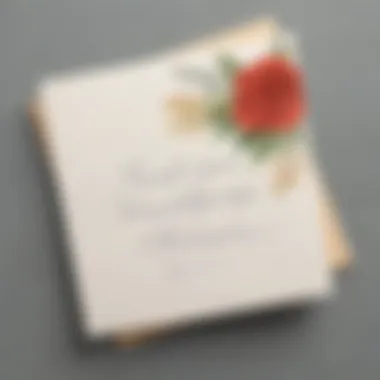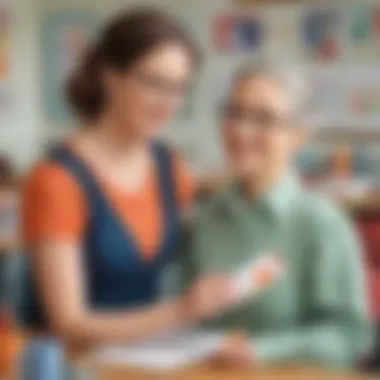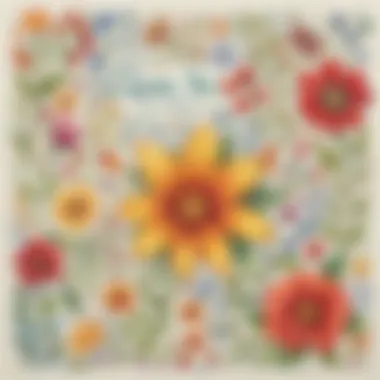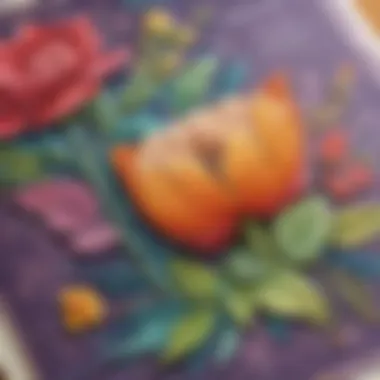Crafting a Thoughtful Thank You Card for Your Teacher


Intro
Expressing gratitude is a powerful act, especially in education. Educators shape not only our knowledge but also our character and perspective. Crafting a thank you card for a teacher is a thoughtful way to acknowledge their hard work and dedication. Although this may seem simple, the impact of a well-crafted note can resonate far beyond the paper it is written on.
A personalized thank you card can communicate appreciation in a way that generic messages cannot. It's an opportunity to express specific instances where a teacher made a difference in a student’s life. The aim here is not only to say thank you but also to enhance the connection between students and educators.
This guide will break down the essential components of writing an effective thank you card. We will discuss how to personalize your note, the appropriate tone to adopt, and the structure that will convey your message clearly. Each of these elements contributes to crafting a meaningful card that your teacher will cherish.
Understanding the Importance of Thank You Cards
Thank you cards hold a special place in the realm of education. They serve not just as notes of appreciation but also as powerful tools to reinforce the bond between students and teachers. Recognizing the hard work of educators can promote a positive atmosphere in the classroom. This appreciation encourages teachers to continue making an impact on their students' lives.
The act of giving a thank you card is significant. It represents recognition of the effort and dedication that teachers put into their work. In an age where educational resources and supports may seem scarce, showing gratitude can have a deep emotional effect. A small gesture can go a long way in affirming teaching as a valued profession. It increases motivation and inspires teachers to give their best every day.
When children learn to express their thanks, they are practicing important skills. Writing thank you cards teaches commitment, reflection, and responsibility. This process adds to their personal growth by developing their writing abilities and emotional intelligence. Ultimately, a well-thought-out thank you card can foster respect and admiration for educators.
"Appreciation is a wonderful thing. It makes what is excellent in others belong to us as well." - Voltaire
The Role of Appreciation in Education
Appreciation plays a vital role in the educational process. It is not only about acknowledging how much effort teachers put in but also about fostering a sense of community. When students express gratitude, it creates a collective environment where educators feel valued.
Being appreciated can greatly enhance a teacher's enthusiasm for their work. This acknowledgment can uplift their spirits in times of stress or fatigue, reinforcing their commitment to teaching. When teachers know their efforts are seen and acknowledged, they are more likely to engage with their students positively.
A simple thank you card can address this need. It serves as a tangible reminder that what they do does matter, encouraging them to continue shaping young minds.
Building Relationships Through Gratitude
Gratitude acts as a bridge in the relationship between students and teachers. It opens channels for communication and respect. When a student expresses their thanks, it goes beyond mere words—it signifies understanding and recognition. This can lead to a stronger bond between teachers and students.
The process of acknowledging a teacher's effort can also teach important lessons in empathy and kindness. Students learn that building relationships matters and that appreciation is a key element of that process.
In summary, it’s clear that thank you cards are more than just cards. They are instruments for change and growth, both for students and teachers. Expressing thanks through a card can have lasting effects, not just on the moment it is received but on the broader educational experience.
Choosing the Right Card
Selecting the appropriate thank you card is a crucial step in expressing gratitude to your teacher. The card serves as a tangible representation of your appreciation. A well-chosen card can amplify your message, while a poorly chosen one may dilute or diminish its impact. This section will explore the various types of thank you cards available and the important design considerations that should inform your choice.
Types of Thank You Cards
Store-Bought Cards
Store-bought cards are a convenient option for many. They are readily available in various shops and online, offering a wide selection of pre-designed options. One key characteristic of these cards is their professional finish. This makes them a popular choice for those who want a polished look without spending too much time on creation.
The unique feature of store-bought cards is their variety. They come in many styles, colors, and messages, which can appeal to different tastes. However, the disadvantage is that they might lack a personal touch, and your message could feel less heartfelt compared to a card you create yourself.
Handmade Options
Handmade thank you cards provide a more personal touch. They reflect your effort and creativity, which can be particularly meaningful for educators. One of the key characteristics of handmade cards is the individuality they offer. Each card can be unique in design, allowing you to express your personality or specific experiences related to your teacher.
The unique feature of handmade options is the ability to customize every aspect, from the paper used to the design elements. While this personal touch usually enhances the emotional resonance of the message, it requires more time and effort, which might not suit everyone's schedule.


Electronic Cards
Electronic cards are an increasingly popular choice in today's digital age. They are easy to send and can reach your teacher almost instantly. One significant characteristic of electronic cards is their convenience. You can create and send them quickly, using various online platforms.
A unique feature of electronic cards is the ability to include multimedia elements, such as music or animations. This can make them more engaging than their physical counterparts. However, some might consider electronic options less formal and lacking the tangible quality that comes with physical cards.
Considerations for Design
Color Schemes
Color schemes play a vital role in the overall impact of a thank you card. The choice of colors can evoke certain feelings. Soft, warm colors often convey kindness and appreciation, making them a beneficial choice for thank you cards. Choosing the right color scheme can enhance the aesthetic of your message and add to the emotional appeal.
The unique attribute of color is its psychological effect. Different colors can invoke various emotions and represent particular moods. For example, blue can convey serenity, while yellow represents positivity. However, clashing colors can confuse the recipient and distract from your message.
Images and Illustrations
Incorporating images and illustrations can elevate your thank you card's design. Visual elements can break up text and draw the reader’s eye. A well-selected image can reinforce your message of gratitude, making your card memorable and engaging.
One key characteristic of images is their ability to convey emotions instantly, often more effectively than words. However, it’s essential to select images that are relevant and resonate with the recipient. Overly complex illustrations may distract rather than enhance your message.
Fonts and Text Layout
The choice of fonts and text layout is crucial for readability and overall appeal. A clear, legible font is essential to ensure your message is easily understood. The layout should be organized, guiding the reader’s eye through your message. Choosing appropriate fonts can communicate your tone directly.
The unique feature of text layout is its role in creating a visual hierarchy, where important points stand out. However, using too many different fonts can create a chaotic look, making your card feel cluttered and hard to read. A consistent font style aids clarity and professionalism.
Structuring Your Message
The way you structure your message is essential in conveying appreciation effectively. A well-structured message helps the recipient, in this case your teacher, understand the sentiment you wish to express clearly. It is important to have a logical flow of ideas in your message so that your gratitude comes across as genuine and heartfelt. Structured messages also help keep your thoughts organized, which prevents you from leaving out crucial points.
Opening Lines
Greeting the Teacher
Greeting the teacher sets the tone for the card. It is not just a simple formality but a way to show respect and acknowledgment. A personal greeting, such as "Dear Mr. Smith," feels warm and direct. This approach enhances the sense of connection. It allows the card to feel more intimate and tailored. A friendly greeting can create a positive first impression and encourages the reader to engage with the content that follows. It is often beneficial to incorporate a positive note in the greeting, perhaps mentioning something specific about their teaching style or class. However, be careful not overdo it; simplicity ensures sincerity.
Acknowledging the Occasion
Acknowledging the occasion of the thank you card is significant. It provides context to your gratitude. You may want to mention a specific event, such as the end of the school year or a successful project. Acknowledgment not only clarifies the reason you are expressing thanks but also underscores the specific impact that event had on you. This makes the message feel targeted and meaningful. The key benefit is that it sets the stage for the gratitude to follow, making your message coherent.
Expressing Gratitude
Expressing gratitude is the heart of your message. It is crucial that the reader feels the sincerity of your thanks. Utilize straightforward language that resonates with emotional weight. Saying "Thank you for helping me with my math skills," for example, shows the teacher exactly what you appreciated. Avoid vague phrases; specificity provides clarity. A genuine expression of gratitude will resonate more strongly than generic statements, bringing depth to your sentiments.
Specific Examples of Impact
Highlighting Personalized Experiences
Highlighting personalized experiences is a powerful way to make your message memorable. When you relate how a teacher specifically influenced your learning, it adds a unique touch. Perhaps they took the time to explain a difficult concept to you. This specificity reduces the message's generality and emphasizes the personal connection you have. It shows the teacher that you value their unique contributions to your education. Including personal anecdotes creates a lasting impression, establishing a deeper connection.
Recognizing Efforts in Teaching


Recognizing efforts in teaching relates directly to acknowledging what your teacher does behind the scenes. Mentioning these efforts adds layers to your gratitude. For instance, you can reference their dedication to planning engaging lessons or their support during challenging times. Recognizing these efforts conveys an understanding of the hard work teachers put into their role. This acknowledgment nurtures respect and appreciation, which can be very encouraging for them.
Closing Statements
Reiterating Thanks
Reiterating thanks in your closing is not merely redundant, but a thoughtful way to leave a lasting impression. Reinforcing your gratitude at the end reinforces your message. It reminds your teacher again of their impact. Simple phrases like "I really appreciate all that you do" serve this purpose well. A strong reiteration ensures the core message resonates and lingers after the card is read.
Well Wishes for the Future
Well wishes for the future add a forward-looking touch to your card. It creates a feeling of continuity in your relationship with the teacher. You might say something like, "I wish you all the best in the coming school year." This shows your support for their future endeavors, bridging the current moment with what lies ahead. It serves to maintain a positive relationship going into the future.
Tone and Style Considerations
When creating a thank you card for your teacher, tone and style play a vital role in conveying your message effectively. Selecting the right tone—either formal or informal—can significantly impact how your appreciation is perceived. The style should reflect not only your relationship with the teacher but also the context of the message. Understanding these elements can enhance the emotional depth of your card.
Formal vs. Informal Tone
A formal tone may be appropriate when the teacher-student relationship emphasizes respect and professionalism. If you are expressing your thanks for a significant achievement, such as a graduation or completion of a major project, a more structured and polite language can be ideal. This might include phrases like "I would like to express my deep gratitude for your guidance and support". Such wording presents a thoughtful acknowledgment of the teacher's role in your academic journey.
Conversely, an informal tone can be suitable for more casual contexts. If your relationship with the teacher is more personal, you might opt for a friendly approach. Use conversational language and a relaxed style to convey your thanks. For instance, instead of saying "I truly appreciate your efforts", you might say "Thanks so much for all you do!" This choice often works better when expressing gratitude for everyday support.
Using Clear and Concise Language
Clarity is essential in communication, especially in a thank you card. A straightforward message ensures that your thoughts are easily understood. Avoid complex jargon or overly elaborate sentiments. Instead, use simple language that captures your feelings without confusion. Consider structuring your message into short sentences that get directly to the point.
For example, "I appreciate your help in class" is clear and effective. It avoids any ambiguity and conveys a strong message of gratitude.
Important: Aim for precision. Each word should contribute to the overall message of appreciation.
In summary, your choice of tone and style shapes the essence of your thank-you card. Whether you choose formal or informal language, ensure it aligns with your relationship with the teacher. Furthermore, utilizing clear and concise language enhances the card’s effectiveness in expressing gratitude.
Personalizing Your Card
Personalization is more than a mere aesthetic choice; it fundamentally shapes the message conveyed in your thank you card. Crafting a thank you card for a teacher involves the delicate balance of heartfelt sentiment and personal connection. When you personalize your card, you demonstrate your investment in the educator's efforts. This not only establishes a stronger bond but also enhances the emotional impact of your message. Personalization allows you to highlight specific experiences, fostering genuine appreciation for the teacher's contribution.
Including Personal Experiences
Including personal experiences is essential in making a thank you card unique. This approach allows the recipient to see how their efforts have directly affected a student's life. For instance, it’s effective to mention a memorable lesson, a project that stood out, or moments when the teacher provided additional support. By reflecting on these experiences, you create a narrative that resonates on a deeper level. This specific acknowledgment makes your appreciation feel sincere and thoughtful.
Signature and Addition of Personal Touches
Signatures
Signatures serve a dual purpose in thank you cards. Firstly, they confirm the sender's identity, which matters significantly in a personal note. Additionally, a signature can evoke a familiar connection. The handwritten nature of a signature showcases the time and consideration put into the card. A unique characteristic of signatures is their ability to convey personality, whether it's a simple name or an artistic flourish. This personal touch is beneficial because it provides authenticity, reinforcing the genuine aspect of your gratitude.
Small Drawings or Doodles
Small drawings or doodles can enhance your card in playful ways. They add a visual element that can make the card feel more inviting. These simple illustrations, whether of a smiley face or something related to the subject the teacher teaches, can amplify the emotional resonance of the message. While they contribute a whimsical quality, such touches can also show creativity and effort. However, it is essential to ensure that any doodles remain tasteful and relevant to maintain the card's sincerity. Thoughtful drawings may also evoke an emotional connection, reinforcing the gratitude expressed in words.
Presentation of the Card


The presentation of a thank you card carries significance beyond the written words. It encapsulates the thoughtful effort you put into expressing appreciation. A well-presented card enhances the impact of your message, making it feel special to the recipient. It shows that you value the teacher's contributions and took the time to select or create something meaningful. Consequently, if the card looks appealing, it adds an extra layer of sentiment, encouraging the teacher to cherish it.
Envelopes and Wrapping
Choosing the Right Envelope
The right envelope complements the thank you card. It serves as the first point of contact for the teacher. An envelope that fits well—neither too tight nor too loose—adds to the overall impression. Using envelopes in vibrant or calming colors can also reflect the tone of your message. A well-selected envelope can convey thoughtfulness and create expectations about the contents.
A unique feature of choosing the right envelope is its ability to enhance presentation. A brightly colored envelope may provoke curiosity, while a classic white one may convey formality. The choice of simple or decorative designs contributes to the card's visual appeal. However, be cautious; an overly ornate envelope may distract from the card's message. This delicate balance is essential in achieving a polished look.
Consideration of Presentation Style
The style of presentation you choose can influence the card's reception as well. Different occasions may call for different styles. For example, a simple presentation with minimal embellishments may work well in more formal settings. In contrast, a festive approach may better suit a special occasion such as a graduation or teachers' day.
A key characteristic of considering presentation style is coherence. The wrapping and presentation should align with both the card's message and the teacher’s personality. A personalized touch, such as using a ribbon or a handmade label, can make a simple card seem extraordinary. Make sure the style does not overshadow the message but amplifies it. This combination can effectively convey gratitude and thoughtfulness.
Delivery Methods
In-Person Delivery
Delivering the card in person allows for a stronger personal connection. Handing over the card face-to-face demonstrates sincerity. It shows that you dedicated time and effort not just to the message, but also to the delivery. This approach creates an opportunity for immediate interaction, where you can express your gratitude verbally alongside the written note.
One unique feature of in-person delivery is the ability to observe the recipient’s reaction. This moment can enhance the experience for both the giver and the receiver. However, it might not always be convenient, especially in large schools. Timing might clash with the teacher's busy schedule, causing stress for all parties involved.
Mailing Options
Mailing the card offers convenience and can reach the teacher even if they are not in the classroom. It allows you to send your appreciation regardless of location, providing flexibility. This option is particularly useful during holidays or breaks when face-to-face delivery may not be feasible.
A notable feature of mailing options is the element of surprise. A card arriving unexpectedly can brighten a teacher's day. However, be aware of mailing costs and delivery times, which can affect when the recipient receives the card. Ensure you send it in advance, so it arrives at an appropriate time, maintaining the intended impact of your gratitude.
"The effort put into the presentation of your card is key to conveying your appreciation. It’s not just what you say, but how you say it that matters."
In summary, the presentation and delivery of a thank you card play crucial roles in its effectiveness. They can set the tone for how the card is perceived, impacting the heartfelt message you wish to convey.
Final Thoughts on Appreciation
Crafting a thoughtful thank you card for a teacher is more than just a simple act of writing. It represents an acknowledgment of the invaluable role teachers play in shaping young minds and fostering education. In this article, we have explored numerous aspects of creating effective thank you cards that resonate with educators.
Understanding the significance of gratitude in educational settings is crucial. When students express their appreciation, it not only uplifts the morale of teachers but also encourages a positive learning environment. Conveying thankfulness reflects the values of respect and acknowledgment, which are vital components of any educational journey.
Continuing the Culture of Gratitude
To embed gratitude within the student community, it is essential to make appreciation a regular part of the culture. Thank you cards can serve as one of many tools for instilling this value. Encouraging children to express gratitude fosters social-emotional growth. When students take a moment to reflect on the contributions of their teachers, they develop a sense of empathy and respect.
Here are some ways to nurture a culture of gratitude:
- Start simple. Encourage students to write thank you notes not just to teachers but also to peers and family members.
- Introduce gratitude days in classrooms where everyone shares positive experiences.
- Share stories of individuals making a positive difference, highlighting the importance of recognizing contributions.
By actively promoting gratitude, schools create an atmosphere where appreciation is expected and celebrated. This culture can manifest into students practicing these values beyond the classroom as well.
Encouragement for Future Acknowledgements
Continuous acknowledgment of contributions can lead to stronger teacher-student relationships. It cultivates feelings of belonging among students and provides teachers with a sense of purpose and fulfillment in their profession. Reinforcing this cycle of gratitude will encourage students to reflect positively on their experiences and inspire them to express their thoughts.
Future expressions of appreciation can take various forms. Students can:
- Write letters or create cards at the end of each school term.
- Organize thank you events or simple ceremonies to honor teachers publicly.
- Share their gratitude using social media platforms like Facebook or Reddit to amplify messages of thanks.
Ultimately, these acts of kindness contribute to a harmonious learning environment. Taking the time to acknowledge efforts strengthens the bond between teachers and students. This mutual respect is foundational for successful education.







